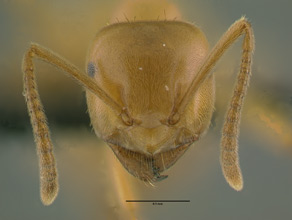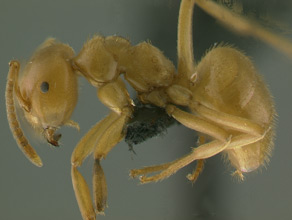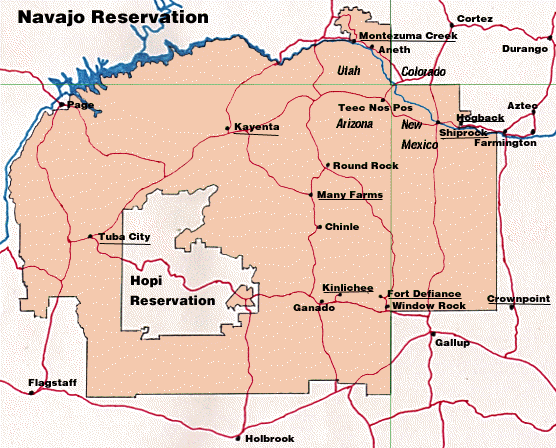- Identification
- A close relative of Lasius umbratus that is best distinguished from this sibling species by a pilosity that is made up of longer and denser hairs. Workers are on average larger than umbratus. Additionally, the body and appendages of workers are uniformly medium yellow, which is typically lighter than most North American umbratus.
- Biology
- Wheeler (1917) provided some of the earliest information about Lasius subumbratus' biology.
At Cloudcroft (Sacramento Mountains, New Mexico) I failed to find subumbratus below 9,000 feet. Its colonies are very populous and live under large stones, usually in the shade of the pines. Its habits, like those of the other subspecies of umbratus, are decidedly hypogaeic.
- additional biology notes...
- Distribution
- Range
- From the maritime provinces of Canada and westward across all of North America.
- Navajo Reservation Records
- Samples being processed.
- Additional Notes
- Temporary Social Parasitism
- Wheeler (1917) provided us with his exquisite blend of field observations and illustrative descriptive text to explain how Lasius subumbratus queens parasitize other ant species (the name Lasius sitkaensis is used throughout the text. This name is now a junior synonym of Lasius pallitarsis).
The observations proving that the young queens of subumbratus establish their colonies with the aid of sitkaensis and neoniger workers may now be transcribed from my note-book:
July 3 and 5. Four colonies of subumbratus were found under large stones. Two were of considerable size and the superficial chambers of the nests were full of black males and golden yellow females ready for the marriage flight.
July 8. The marriage flight of subumbratus must have occurred on July 6 or 7 as there were numerous deflated females running about among the stones on an open, sunny slope where many of the stones covered nests of neoniger. My son Ralph assisted me in carefully turning over the stones and examining these nests. In one area, about 200 feet in diameter, nearly every nest had from one to five deflated subumbratus queens running about in the large shallow superficial chambers. By shading the chambers, which were occupied by numerous neoniger workers and cocoons, the behavior of the yellow queens could be readily studied. They ran in and out of the chambers and galleries leading into the soil and, when accosted by the neoniger workers, made peculiar supplicatory movements with the antennae, precisely like those of Formica consocians queens seeking adoption in nests of F. incerta. The neoniger workers, however, resented the intrusion and frequently seized the legs and antennae of the queens, though they soon released their hold. The queens thus liberated often escaped from the nest and hid under stones near it or even in unfrequented nooks in the superficial chambers of the nest itself. On several occasions we saw a queen seize a neoniger worker, carry it out of the nest and release it uninjured. One queen was seen to snatch up a worker cocoon, carry it out of the nest and conceal it under an adjacent pebble. This is very suggestive of the behavior of the young Formica sanguinea queen that has entered a nest of F. fusca, but though it undeniably shows an interest on the part of the subumbratus queen in the neoniger brood, her method of colony formation is not that of F. sanguinea, for we soon discovered a depauperate neoniger colony which had undoubtedly adopted a subumbratus queen. The latter was moving to and fro very slowly and amicably in the midst of several neoniger workers and their cocoons in a small recess under a stone. The ants were watched for some time and behaved precisely like members of a single colony. That the queens are nevertheless occasionally treated much more severely by the neoniger workers, is apparent from the fact that we found a few recently killed and one partially eaten in the superficial chambers of some of the nests.
July 9. Visited another rocky slope and an adjoining pine forest about a mile east of Cloudcroft and two miles from the locality of yesterday’s observations. Under the stones covering neoniger and sitkaensis nests there were many dealated subumbratus queens eagerly seeking adoption. The following three colonies showed clearly that some of the queens had been or were being accepted:
1. A populous sitkaensis colony under several large contiguous stones among the pines. The superficial galleries of the nest were filled with workers and worker, male and female cocoons nearly ready to hatch. Under two of the stones a couple of subumbratus queens was found, each lurking quietly in a little cavity at the edge of a mass of cocoons nearly filling a large, shallow superficial chamber.
2. A similar but even larger sitkaensis nest, also under a pile of stones, under three of which subumbratus queens were found. One of the queens was in a small cavity at the edge of a heap of cocoons while each of the others was resting on the very center of a collection of cocoons nearly as large as my palm. These queens had certainly been adopted and the picture presented was precisely like that of the recently adopted Formica consocians queens mounted on the cocoons and surrounded and fondled by the workers of F. incerta (Wheeler 1906). When the nest was disturbed the queens hurried into the galleries and disappeared in the soil. They had evidently become strongly negatively heliotactic, unlike queens that are still running about on the soil immediately after the marriage flight.
3. A fine sitkaensis nest under a single large stone among the pines had an adopted subumbratus queen surrounded by dozens of workers in the center of a pile of worker and female cocoons nearly as large as my hand. She quickly slipped into a burrow and was only recovered by digging down into the soil to a depth of more than six inches. In this nest a few of the female sitkaensis pupae were naked, i.e., not enclosed in cocoons.
Further search in the same locality brought to light two mixed colonies consisting of subumbratus and sitkaensis workers. I failed to find the queens of the former species, which were probably present but hiding deep in the soil. The failure to find them is not surprising as one very rarely secures the mother queen of a fully developed colony of any of our species of Lasius without extensive and very careful excavation of the nest.
The foregoing observations show that the subumbratus queen has to acquire the brood odor of the host before she can be accepted. She therefore lurks very near the cocoons in a small earthern cavity and somewhat later, in the early stage of adoption, like Formica consocians, takes up a position on the brood. This renders her immune to attack by the host workers and gradually accustoms them to her presence. That adoption can be secured in very populous and flourishing colonies of sitkaensis is shown by the observations of July 9. - General Biology/Ecology
- Wilson (1955) nicely summarized additional information about the biology of Lasius subumbratus (the name Lasius sitkaensis is used throughout the text. This name is now a junior synonym of Lasius pallitarsis).
Cole's New Mexican collections were made under stones in a variety of habitats, including a dry, open slope, an alpine meadow, and spruce-aspen, spruce-pine, and pine-aspen forests. Wheeler (1917b) found it common at Cloudcroft, New Mexico, under stones in pine forest. I found two colonies in pine-fir forest on a southern slope of the San Francisco Mountains of Arizona, one under a stone and one under a rotting log. In the southern Rocky Mountains subumbratus is clearly a high-elevation species; thus far it has been found only well above the lower elevational limits of sympatric populations of sitkaensis, neoniger, crypticus, and sitiens, and it ranges at least to the upper elevational limits of these species. In New Mexico Cole encountered it between 7400 and 10,000 feet, and at Cloudcroft Wheeler was unable to find it below 9000 feet. My Arizona colonies were found at about 8000 feet.
Additional evidence is available to indicate that sitkaensis is the principal, if not the only, host. Cole has found mixed subumbratus-sitkaensis colonies at Tesuque Canyon and Eagle Nest, New Mexico; the parasite workers from the latter locality are minimas and much smaller than the associated host workers. In another nest at the second locality a single dealate subumbratus queen was found with sitkaensis workers. Finally, there is in the Museum of Comparative Zoology a series of 6 dealate subumbratus queens associated with sitkaensis (Bedford, Nova Scotia; W. Reig leg. j MCZ). - Etymology
- Morphological. L. sub- somewhat + L. umbratus, meaning this species is similar to Lasius umbratus.
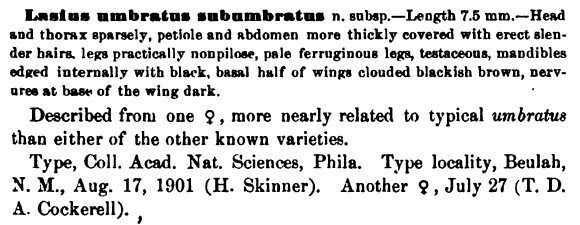
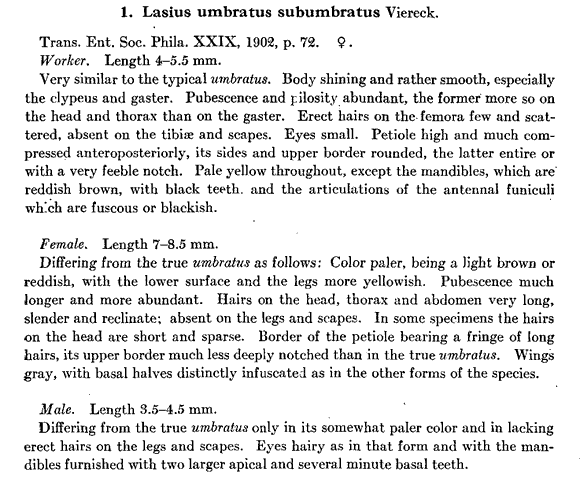
- Literature
- Viereck, H. L. 1903. Hymenoptera of Beulah, New Mexico. Transactions of the American Entomological Society (Philadelphia). 29:56-87.
- Wheeler, W. M. 1910. The North American forms of Lasius umbratus Nylander. Psyche (Cambridge). 17:235-243.
- Wheeler, W. M. 1917. The temporary social parasitism of Lasius subumbratus Viereck. Psyche. 24:167-176.
- Wilson, E. O. 1955. A monographic revision of the ant genus Lasius. Bulletin of the Museum of Comparative Zoology at Harvard College. 113:1-201.
- A note about these publications. The literature cited here is not meant to be an exhaustive list of papers published about this species.
Page authored by David Lubertazzi and Gary Alpert
